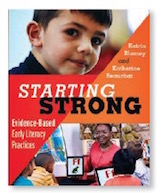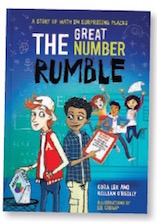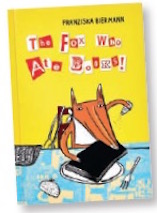reviews
For additional reviews of French-language resources, visit Pour parler profession. With the exception of some classroom sets, items reviewed are available on loan from the Margaret Wilson Library at the College. Contact us at 416-961-8800 (toll-free in Ontario 1-888-534-2222), ext. 679 or email library@oct.ca.

Super Hammy
WRITTEN AND ILLUSTRATED BY OKSANNA CRAWLEY
It's little wonder that Oksanna Crawley has such an intimate understanding of the early reading process. A retired kindergarten teacher who worked extensively with children in Reading Recovery, Crawley's skills as a former radio journalist and her passion for making reading an enjoyable task for young children are evident in the delightful series featuring Super Hammy and his superpowers.
Super Hammy is an attractive package for beginning readers containing 15 small books and an accompanying CD. The star of all the books is an adorable hamster who possesses superpowers. Each book has a single sentence on the left and an illustration of that sentence on the right. Repetition reinforces word recognition and builds up reading vocabulary and confidence.
Throughout the 15 books and three reading levels, other characters like Snowman, Cheese and Little Mouse make appearances. The series promises to make reading fun and simple. It would make an excellent addition to classroom libraries and could be used individually or as a set. Preschoolers would also enjoy these books in their personal libraries where they would be a good addition to shared reading materials.
Super Hammy: My First Reading Series, DC Canada Education Publishing, Ottawa, 2017, one CD and 15 softcover books, ISBN 978-1-77205-206-0, $89.95, individual books can be purchased for $5.95 each, dc-canada.ca
Gail Lennon is a writer and reviewer with more than 35 years of teaching experience at all levels who lives in West Perth, Ont.

Starting Strong
BY KATRIN BLAMEY AND KATHERINE BEAUCHAT
It's a simple and powerful truth that early, effective literacy skills are central to student success. The link between low literacy, disengagement and dropping out of high school are irrefutable. Poor literacy closes doors to future employment and a life rich with possibility.
With that in mind, Blamey and Beauchat, both seasoned primary school teachers, bring their years of experience to their current gigs educating university students in early elementary teaching programs. While recognizing the current pressures facing literacy teachers, particularly those teaching our youngest students, they bring together the most successful strategies for fostering engagement.
They start by considering four proven instructional approaches to literacy: standards-based, evidence-based, assessment-based and student-based. After clearly explaining each of these instructional practices, they show how they can help improve teaching in all areas of early literacy. While innumerable online teacher resources offer accessible and fun ideas for literacy lesson planning, Blamey and Beauchat caution teachers to ensure that what they bring in to their classrooms is always rooted in solid educational practices.
The book is structured according to early literacy skills: oral language, vocabulary, phonological awareness, word recognition, comprehension and writing skills.
In each of the chapters, a framework is laid out for the way each instructional method can effectively be used to teach those skills. The authors suggest blending and juggling instructional ideas based on the individual circumstances in the classroom dynamic and using the approach that best fits at a given time.
Starting Strong is framed for an American audience, so Ontario teachers would have to adapt the choices to include resources from the Ontario curriculum and for Canadian content.
Starting Strong: Evidence-Based Early Literacy Practices, Stenhouse Publishers, Portland, ME, 2016, softcover, ISBN 978-1-57110-930-9, 240 pages, US$25, stenhouse.com
Nadira Baksh, OCT, teaches history at the Adult Education Centre in the Peel District School Board and recently completed a combined Honours Specialist in English and history.

The Big Book of Nature Activities
BY JACOB RODENBURG AND DREW MONKMAN
"Take one child. Place outdoors in nearby green spaces. Leave for several hours at a time. Repeat daily. Sprinkle in a dash of adventure. Fold in a generous portion of exploration and discovery. Top with wonder and awe. Let rise" This unusual recipe for fostering curious and engaged children introduces The Big Book of Nature Activities, written by long-time environmental educators Drew Monkman and Jacob Rodenburg. The book is essential reading for anyone who wants to show children how to connect with, explore and enjoy their natural world. Making mud pies, catching tadpoles at a nearby wetland, climbing trees or just staring up at the starry night sky are just some of the pleasures that can open the eyes of children to the wonder of the big, wide world.
Organized around the changing seasons, the six main ecological regions of North America, and the flora, fauna, sky and weather specific to those regions, The Big Book of Nature Activities is loaded with detailed descriptions of key natural events and just enough background science to make you want to get out there to get up close and personal with the fascinating world of your own backyard. Citing the growing body of research pointing to the mental and physical health benefits of getting our students outside, the book also warns of the risks to our health and the health of our planet when we lose touch with our natural environment. The basic skills needed for connecting to nature are then carefully laid out. There are dozens of activities linking the exploration of nature to the arts, to language and to the sheer joy of playing outside. The book highlights the wonder of evolution with a wide range of stories and activities, and suggests multiple citizen science projects that both kids and adults can get involved in.
Both authors have extensive experience working with children and adults in classroom and outdoor settings. If you are an educator, a parent, or a person with the simple desire to rekindle a sense of wonder and awe for the world around you, The Big Book of Nature Activities will first inspire and then guide you to do just that.
The Big Book of Nature Activities: A Year-Round Guide to Outdoor Learning, New Society Publishers, 2016, Gabriola Island, B.C., softcover, ISBN 978-0-86571-802-9, 384 pages, $39.95, newsociety.com
Stephanie Benn, OCT, is a science and language teacher in Peterborough at Edmison Heights Public School with the Kawartha Pine Ridge District School Board.

The Great Number Rumble
BY CORA LEE AND GILLIAN O'REILLY, ILLUSTRATED BY LIL CRUMPImagine a town where math is suddenly banned from schools. Now think of one student in this same town trying to persuade the educators and citizens to reverse the ban by proving that math is “everywhere, in everything, and we all use it.” This is the storyline of The Great Number Rumble, a thought-provoking mix of facts and fiction designed to answer two essential questions: What is math and why should we study it?
Jeremy thinks that studying math is a waste of time. His friend Sam knows that math, is about way more than numbers, and is willing to engage in a math debate (the titular number rumble) to prove it. Neon text boxes highlight engaging facts about the history of math, and well-designed sidebars show practical examples connecting math with a range of other subjects like music, science, and physical education where math-letes often become the best athletes. In the end, Sam outsmarts the town and wins the debate by offering to work for one cent a day, with his price doubling every day. Both sides calculate that with exponential growth the town will have to pay Sam almost 11 million dollars in his first month of work alone. Fun DIY challenges and funny headings such as “Crimes and primes” complement the fictional story as it underscores the significant role math plays in our lives.
This updated chapter book would make a wonderful read-aloud as part of a STEM (Science, Technology, Engineering, Math) focus. A section titled “Jeremy wrestles with the weird stuff” could help in math planning for struggling math students. Coaches can use the section on 45-degree angles and gravity to improve the shots of their basketball team. By the end of The Great Number Rumble, one of the central questions has changed from what is math to what isn’t. And the other question? Well, just read the book to be reminded of the many reasons we value numeracy skills so highly.
The Great Number Rumble: A Story of Math in Surprising Places, revised edition, Annick Press, Toronto, 2016, softcover, ISBN 978-1-55451-849-4, 104 pages, $14.95, annickpress.com
Anne Marie Landon, OCT, is a principal with the Renfrew County Catholic District School Board.

Three Little Piggy Banks
BY PAMELA GEORGE, ILLUSTRATED BY MEREDITH LUCE
Ella and Andy are about to turn five years old and they are dreaming big about their haul of birthday gifts. Instead, the twins each receive three piggy banks from their parents, who explain that every week they will be given three dollars in allowance to be allocated to the piggy banks: one for saving, one for sharing and one for spending. After sorting out how much to save and how much to share, the twins set their hearts on a camera and a bike.
Three Little Piggy Banks is a great way to introduce money management to young children and fills a void in our primary education curriculum. The book is prefaced by a note to teachers and parents emphasizing the impact of financial literacy on our lives and how critical it is to engage children at an early age about delayed gratification and keeping track of expenses. By learning how to save, how to share and how to spend, kids are taught the tools they need to avoid living paycheque to paycheque and to dodge debt.
This book could be used as a springboard to talking and learning about financial literacy with children up to Grade 3. Understanding how to grow up to be a financially competent adult is too important to leave to chance.
Three Little Piggy Banks: Financial Literacy for Children, DC Canada Education Publishing, Ottawa, 2016, softcover, ISBN 978-1-77205-176-6, 40 pages, $12.95, dc-canada.ca
Janet Cottreau, OCT, is an occasional elementary school teacher with the Ottawa-Carleton District School Board.

The Fox Who Ate Books
BY FRANZISKA BIERMANN, TRANSLATED BY SHELLEY TANAKA
Mr. Fox literally consumes books in this quirky story with an unconventional hero who likes to read his books lovingly, eat them with gusto, and finally, digest them slowly. Unfortunately for Mr. Fox, he is never quite full, and his grumbling stomach is always craving more literary delights. The foxy bookworm soon runs out of finances to keep him fed and full, which leads him to the library. One day, the horrified librarian discovers his secret. Running out of solutions to feed his belly, Mr. Fox ultimately makes some unwise decisions that land him in jail.
The author has a unique knack for storytelling that will keep young readers ages five to eight engaged. While an amusing story, there are many messages students can take away from these pages. Teachers and parents can reinforce the importance of taking good care of borrowed items — whether from the library or other venues. The consequences and repercussions of stealing can be further studied and applied to real-life situations. Discovering hidden talents in unusual situations is yet another theme to be explored. Students will enjoy this untraditional fairy tale following Mr. Fox on his journey from rags to riches.
The Fox Who Ate Books, Annick Press, Toronto, 2016 (English translation), hardcover, ISBN 978-1-55451-846-3, 56 pages, $19.95, annickpress.com
Joanne Sallay is an education writer and president of Teachers on Call, a personalized home tutoring service that covers all subjects and grades.
